| Microbes in Human Welfare Refresher Course |
| Microbes in Human Welfare Concepts Files |
| Microbes in Human Welfare Master Files |
| Microbes in Human Welfare Revision Note |
| Microbes in Human Welfare Note 1 |
| Microbes in Human Welfare Note 2 |
Microbes in Human Welfare
Table of Contents
- What are microbes?
- What is Microbiology?
- Applications of Microbiology
- Microbes in Household Products
- Microbes as Source of Food
- Microbes in Industrial Products
- Microbes in Sewage Treatment
- Microbes in Production of Biogas
- Microbes as a Biocontrol Agent
- Microbes as Biofertilizers
What are Microbes?
Microbes are available all around, in air, water, soil and so on likewise in extraordinary conditions, extremophiles microbes are developed in media to develop colonies, seen with the bare eye.
Microbes are various – bacteria, fungi, protozoa, bacteria, fungi and minute plants viruses, viroids furthermore prions (proteinaceous agents of infection)
What is Microbiology?
“Micro” – (symbol μ) is a unit prefix in the metric system denoting a factor of 10−6 (too small to be seen with the naked eye), “Bio” – the Greek root word bio means ‘life.’ and “Logy” -logy is a suffix in the English language means “the study of”.
Microbiology is the study of very small living organisms called microorganisms/ microbes.
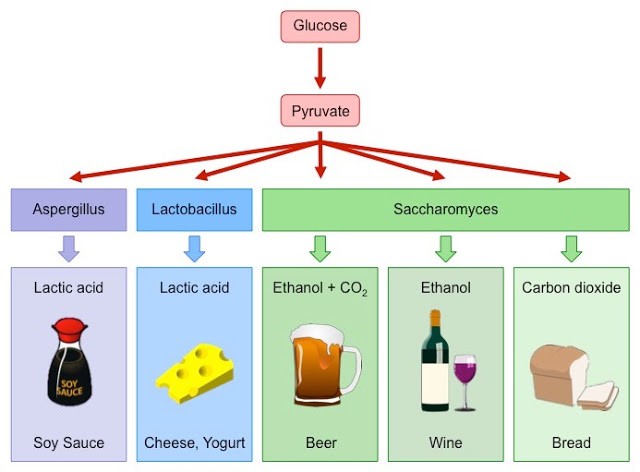
Fig: Role of Microorganisms
Applications of Microbiology
- Food production: bread, beer
- Microbes in biogas production
- As biocontrol agents
- In sewage treatment
- Bioremediation: decontamination of hazardous wastes
- As biofertilizers
- As a source of food single cell protein (SCP)
- Useful industrial products: ethanol fuel, antibiotics, amino acids
- Genetic engineering: pharmaceuticals, vaccines
Microbes in Household Products
- Lactic Corrosive Bacteria (LAB) develop in milk and change it into curd.
- LAB produces acids that coagulate and incompletely process milk proteins.
- LAB enhances dietary nature of milk by expanding vitamin B12
- LAB assumes a critical role in checking disease bringing about microbes.
- Dough used to make dosa and idli is likewise matured by bacteria.
- The puffed-up appearance of the mixture is because of the creation of CO2.
- Baker’s yeast (Saccharomyces cerevisiae) is accustomed to making bread.
- Large openings in ‘Swiss cheddar’ are because of the creation of a huge measure of CO2 by a bacterium named Propionibacterium shermanii.
- The ‘Roquefort cheddar‘ is aged by particular fungi, which gives particular flavor.
Microbes as Source of Food
It alludes to the microbial biomass or aggregate protein add up to separated from uncontaminated microbial cell culture (monoculture) and this may be utilized as a protein supplement. It is utilized in light of the fact that: –
- They have high protein and low-fat substance.
- It is a great wellspring of vitamins especially B-complex.
- It can be created consistently.
- Waste materials are utilized as a substrate for the generation of these proteins.
- SCP life forms develop easily and quickly.
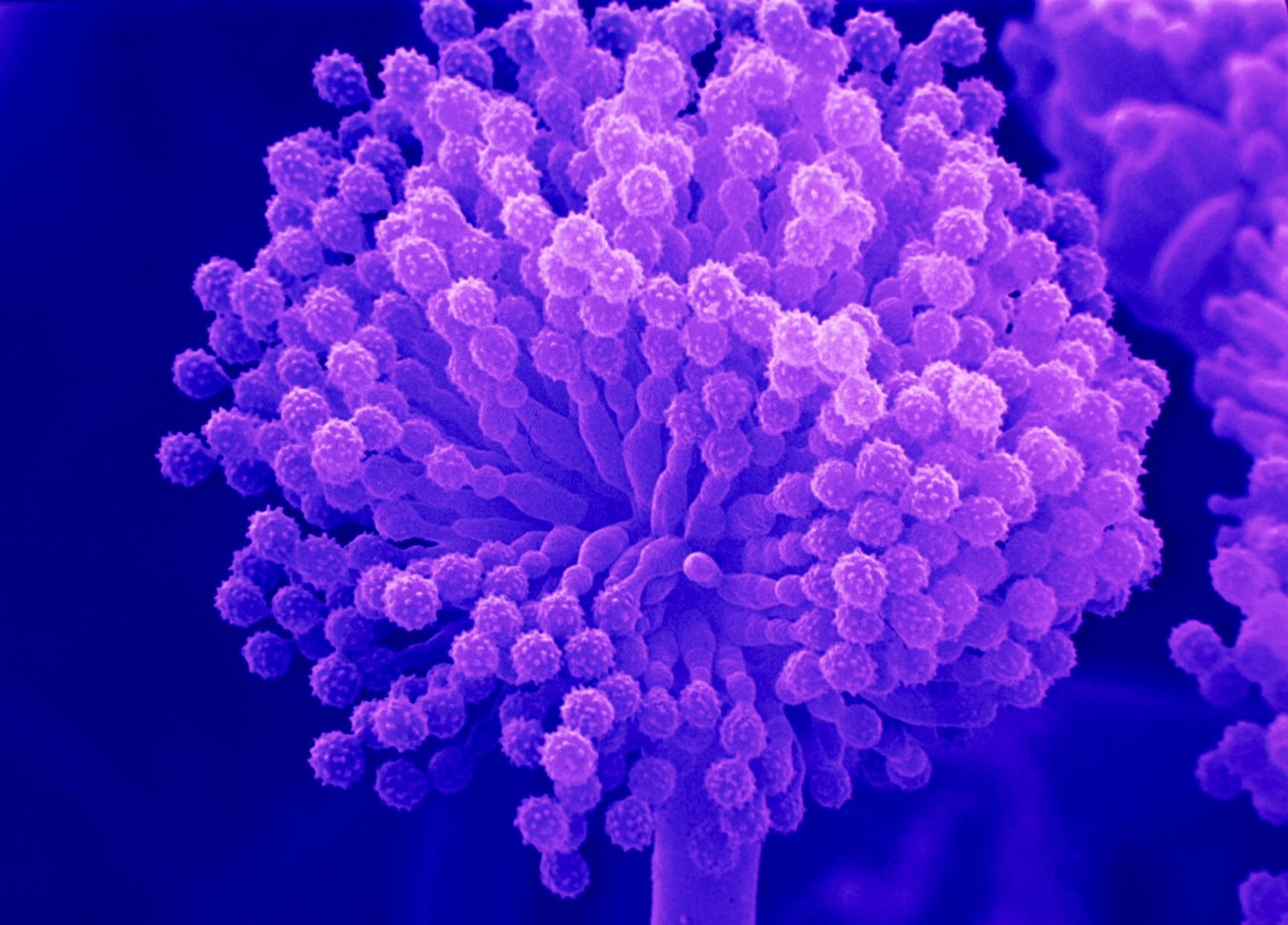
Fig: Single Cell Protein: Filamentous Fungi
Glucose | → | Sweeter Fructose |
Glucose Isomerase |
The above procedure describes the manufacture of Pruteen a tasteless and odorless SCP, used as animal feed.
Microbes in Industrial Products
- Microbes are utilized as a part of industry to combine and develop various items
- Beverages, chemicals, natural acids, vitamins and anti-infection agents are a few cases.
- Microbes are developed in huge vessels called fermenters.
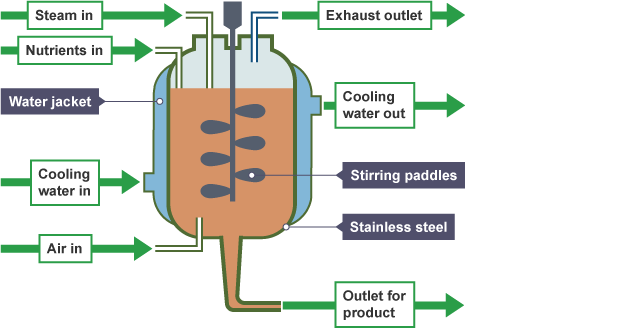
Fig: A fermenter in industry
Fermented Beverages
- Yeasts are utilized for generation of beverages like rum, beer, wine, brew, whiskey, liquor or rum.
- Saccharomyces cerevisiae ordinarily called ‘brewer’s yeast utilized for fermenting malted oats and natural product juices to deliver ethanol.
- The sort of crude material utilized for fermentation and preparing diverse sorts of mixed beverages are delivered.
- Wine and lager are delivered without distillation.
- Whisky, rum, and brandy are delivered by distillation of the fermented soup.
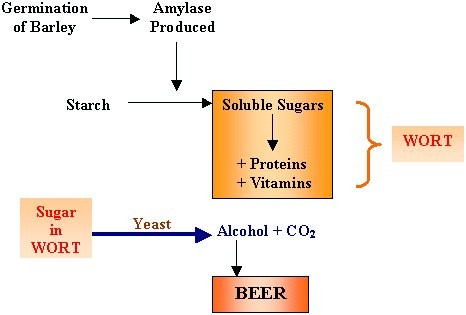
Fig: Beer is made from malted barley
Antibiotics
- Antibiotics are the synthetic substances which are delivered by a few microbes and can kill or retard the development of different microbes.
- The first anti-infection found is the penicillin, prepared from a fungus Penicillium notatum.
- Antibiotics have extraordinarily enhanced our ability to treat dangerous diseases, for example, diphtheria, plague, leprosy and whooping cough.
| Name of Antibiotic | Obtained From |
Terramycin | Streptomyces rimosus |
Erythromycin | Streptomyces erythraeus |
Chloromycetin | Streptomyces venezuelae |
Aureomycin | Streptomyces aureofaciens |
Neomycin, novaboium | Streptomyces spp. |
Penicillin | Pencillium notatum |
Tetramycin | Streptomyces griseus |
Streptomycin | Streptomyces griseus |
Actinomycetes | Micromonospora spp. |
Chemicals, Enzymes and other Bioactive Molecules
- Aspergillus niger (a fungus) produces citric acid.
- Clostridium butylicum (a bacterium) deliver butyric acid.
- Acetobacter aceti (a bacterium) gives acetic acid.
- Lactobacillus (a bacterium) gives lactic acid.
- Lipases are utilized as a part of cleanser delivered by microbes.
- Pectinase, proteases, and cellulase make packaged organic product juices clearer.
- Streptokinase delivered by Streptococcus is utilized as a ‘coagulation buster’, for expelling clumps from the veins.
- Cyclosporin-A delivered by a fungus called Trichoderma polysporum is utilized as an immunosuppressive drug as a part of organ transplantation.
- Statins delivered by Monascus purpureus are utilized as agents that lower the blood cholesterol levels. It goes about as a competitive inhibitor for the compound in charge of amalgamation of cholesterol.
- Gibberellins are created in more noteworthy mass by soil fungi Gibberella fujikuroi.
Some commercial enzymes and source microorganisms:
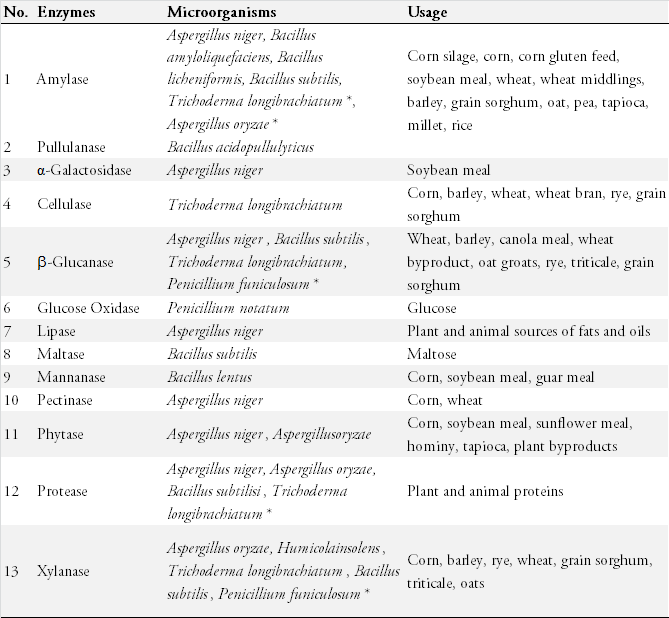
Microbes in Sewage Treatment
- The squander water is produced in urban communities and town containing human excreta. This metropolitan water-water is called sewage.
- Before transfer to the common body, sewage is dealt with inside sewage treatment plants (STPs) to make it less contaminating.
- Treatment is finished by heterotrophic microbes normally introduce in sewage.
Primary treatment
- Involves the physical expulsion of particles – small and big from sewage through sedimentation and filtration.
- Initially, the debris that is found floating is expelled by consecutive filtration.
- The grit (small rock pieces and soil) are evacuated by sedimentation.
- The solids that settle down frame the primary sludge, and the supernatant structures the effluents.
- The effluents obtained from the primary or initial settling tank is further taken for secondary treatment.
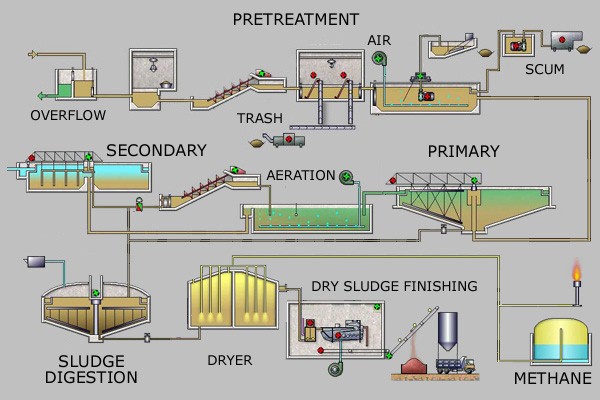
Fig: Above diagram illustrates the process of waste water treatment
Secondary treatment or Biological treatment
- The initial effluent is passed into huge air circulation tanks.
- This permits a vigorous development of helpful high-impact microbes into flocs.
- The development of microbes devours the significant part of the natural matter in the profluent. This altogether decreases the BOD (Biochemical Oxygen Demand) of the profluent.
- BOD alludes to the measure of oxygen required to oxidize total natural matter by bacteria that is present in one liter of water.
- BOD is the measures of the natural matter present in the water.
- More the BOD of the wastewater more is its contaminating potential.
- Once the BOD of sewage is lessened essentially, the effluent is then passed into the settling tank where the bacterial “flocs” are permitted to settle down. This sediment is alluded as activated sludge.
- Small portion of activated sludge is pumped back to air circulation tank to serve as the inoculums.
- The remaining slop is pumped into anaerobic sludge digester.
- In the anaerobic sludge digester, there are different sorts of bacteria which develop anaerobically and digest and process the bacteria and fungi in the sludge.
- During this assimilation bacterium create biogas, (blend of methane, hydrogen sulfide and carbon dioxide)
- The effluent obtained from secondary treatment plant is discharged into normal water body like waterways and streams.
- Yamuna Action Plan and Ganga Action Plan were started by Ministry of Environment and Forest to spare these real streams of our nation.
- It is proposed to assemble countless treatment plants so that only the treated sewage might be released into the streams.
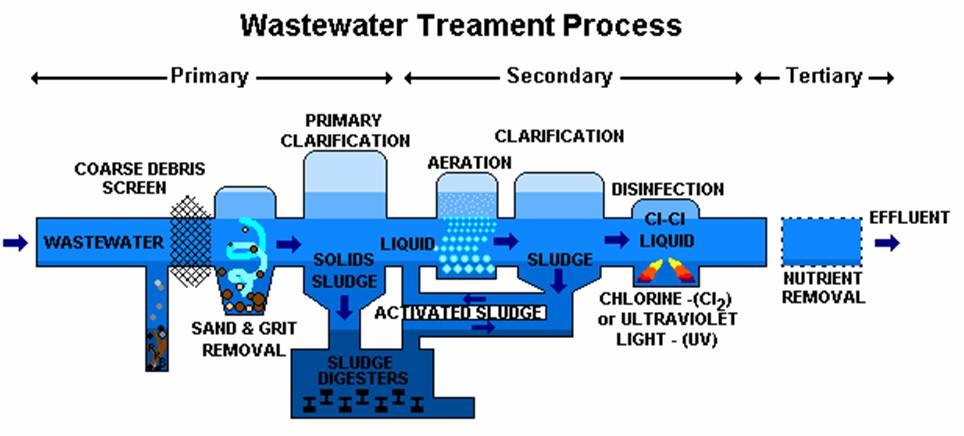
Microbes in Production of Biogas
- Biogas is a blend of gasses (overwhelmingly methane) created by the microbial movement and is utilized as fuel.
- A few bacteria develop anaerobically on cellulosic material; deliver a huge measure of methane alongside CO2 and H2S. These bacteria together are known as methanogens. One basic bacterium is Methanobacterium.
- These bacteria display in the rumen of cattle assumes a fundamental part in the sustenance of dairy cattle by processing cellulose. Henceforth the excreta (fertilizer) utilized for the creation of biogas.
This is a multistep chemical as well as a biological process that is useful in waste administration as well as vitality creation. There are four essential strides of anaerobic processing that incorporate hydrolysis, acidogenesis, acetogenesis, and methanogenesis. All through this whole procedure, vast natural polymers that make up Biomass are separated into smaller particles by microorganisms and chemicals. Towards the end of the anaerobic assimilation process, the Biomass is changed over into Biogas, to be specific carbon dioxide and methane, and in addition digestate and wastewater.
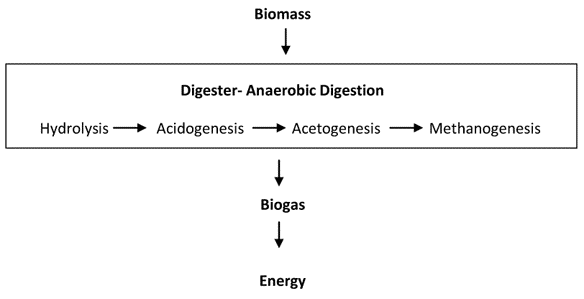
Fig: Procedure of biogas production
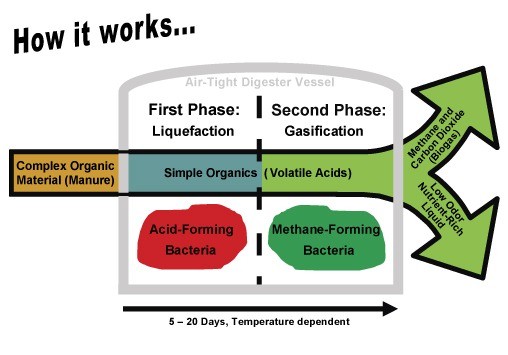
Fig: Biogas production from human waste

Fig: Schematic diagram of biogas process
Biogas microbes comprise of an expansive gathering of complex and diversely acting microorganism species. Three sorts of bacteria are included: Clostridium, Pseudomonas, Methanobacillus and Methanococcous spp.
Microbes as a Biocontrol Agent
- Biocontrol alludes to the utilization of organic techniques for controlling plant diseases and vermin.
- Effect of utilization of concoction, bug spray, and pesticide to control disease and vermin:
- These chemicals are dangerous and to a great degree destructive to people and creatures
- Polluting our surroundings (soil, ground water), natural products, and vegetables.
- Soil is contaminated through utilization of weedicides to evacuate weeds.
Biological control of pest and disease
- Use of biocontrol measures will extraordinarily diminish our reliance on lethal concoction and pesticides.
- The Dragonflies and Ladybird are utilized to dispose of aphids and mosquitoes.
- Bacillus thuringiensis (Bt) are used to control caterpillars of butterfly.
- Spores that have been dried are blended with water and showered onto powerless plants, where these are eaten by the larvae of insects.
- In the gut of the hatchlings, the poison is discharged and the hatchlings die.
- Trichoderma, a free-living fungus is used to control a few plant pathogens.
- Baculoviruses are pathogen that assault different arthropods and insects.
- The greater part of baculoviruses utilized as organic control specialists are in the family Nucleopolyhedrovirus.
- These viruses are an excellent contender for narrow- range, species- specific insecticidal application.
- They have no negative effects on plants, warm-blooded creatures, fowls, fishes, and so forth.
- This is exceptionally useful in integrated pest managements (IPM).
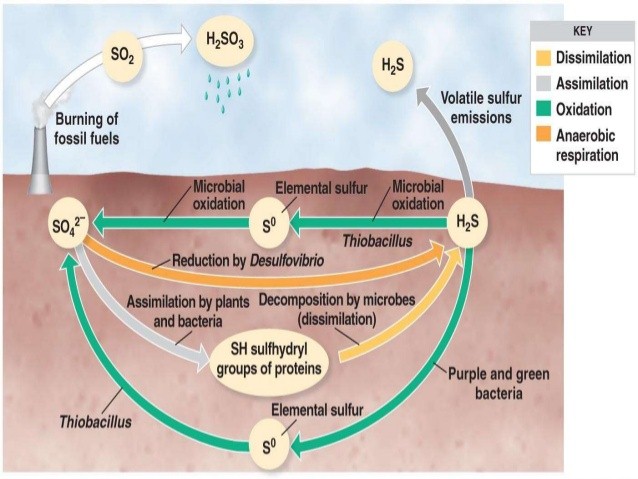
Fig: Soil microorganisms as Biocontrol
Microbes as Biofertilizers
- Biofertilizers are living organisms that improve the supplement nature of the soil.
- Important biofertilizers include fungi, bacteria, and cyanobacteria.
- Rhizobium frame root knobs in leguminous plants and fixes nitrogen present in the air.
- Azospirilium and Azotobacter are free-living bacteria that fix nitrogen present in the atmosphere and in this way expanding nitrogen content of soil.
- Mycorrhiza: fungi that are symbiotically connected with the roots of the plants.
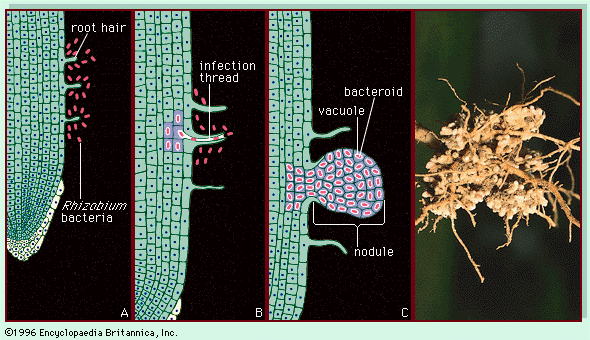
Fig: Rhizobium bacteria
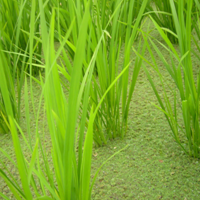
Fig: Azzola biofertilizer
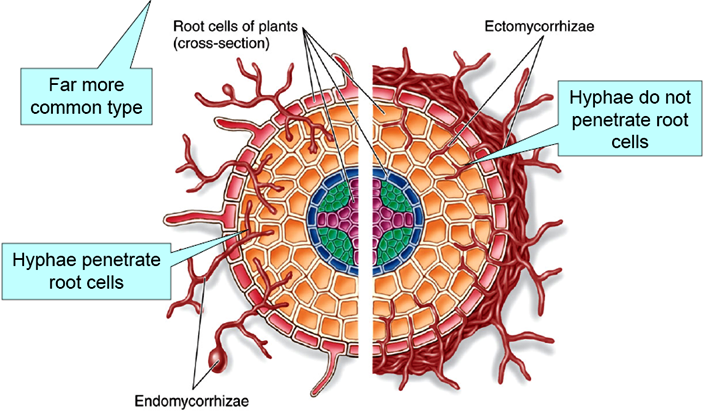
Fig: Mycorrhizae
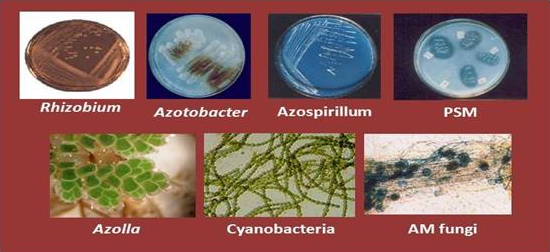
Fig: Different types of Biofertilizers
- Mycorrhiza:
- Provide phosphorus present in the soil to the plants.
- Make the plant impervious to the root-borne pathogen.
- Increase resistance to drought and salinity.
- Cyanobacteria like Nostoc, Anabaena, and Oscillatoria and so on:
- Fix air nitrogen.
- Add natural matter to the soil and
- Increases the fertility of the soil.